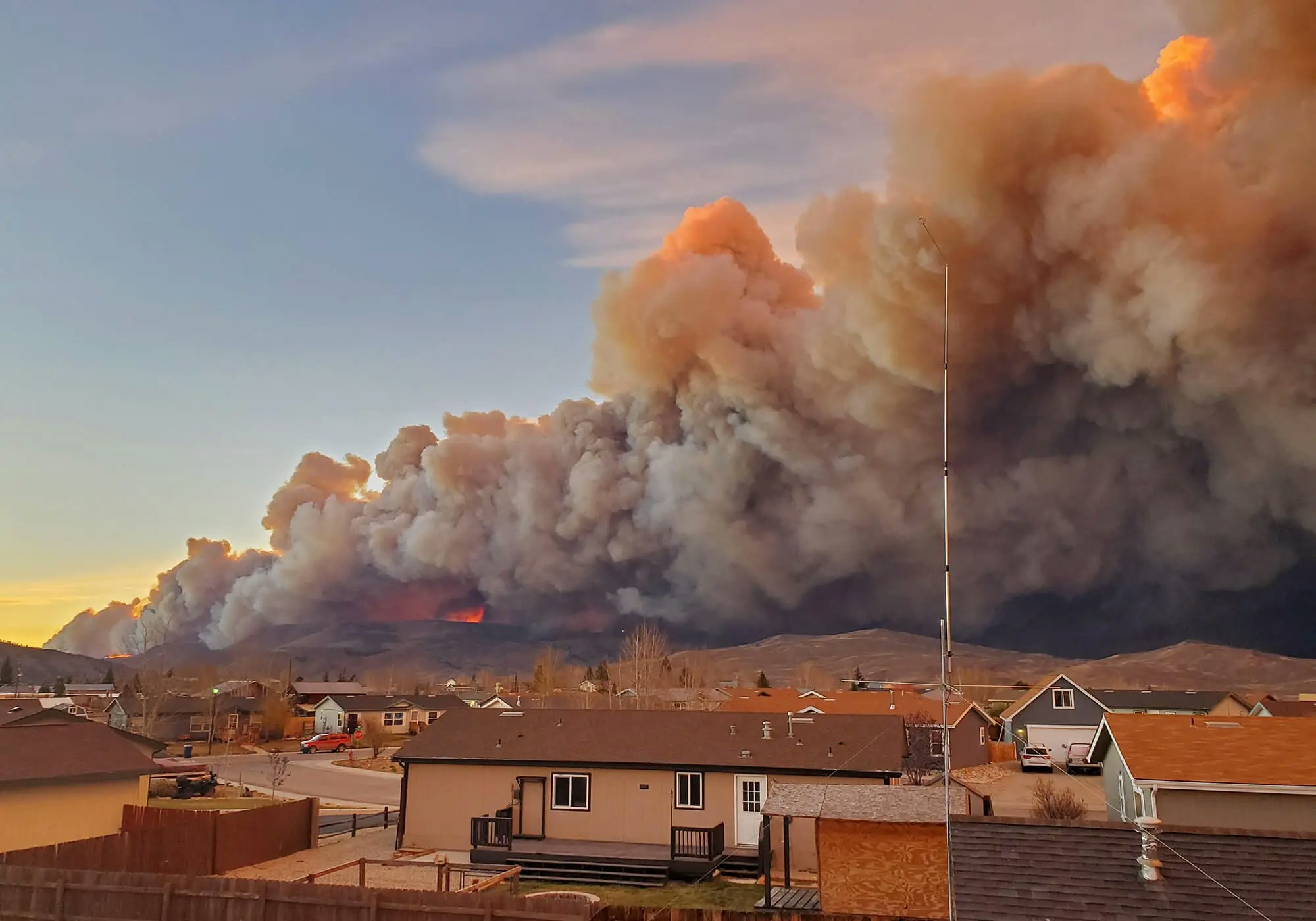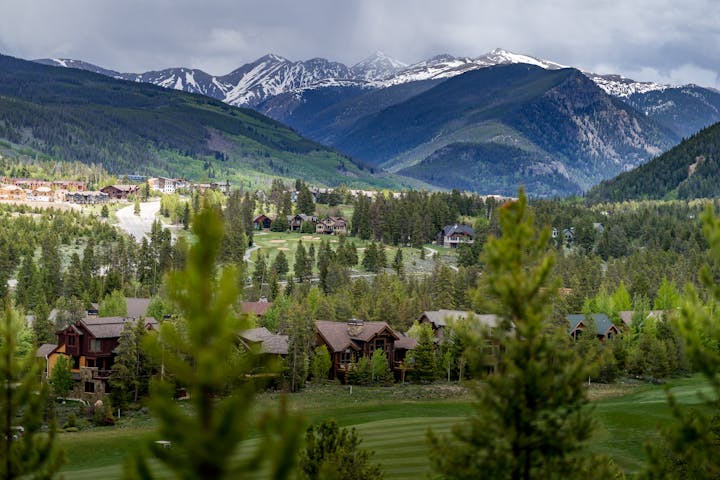Fighting Megafires

May 16, 2021 | Alex Terlecky
An Interview with Grand Fire’s Assistant Chief
Wildfires have always been a part of the natural lifecycle of Colorado’s forest. However, as Colorado endured the three largest wildfires in the state’s history in 2020, firefighters witnessed stronger and more prolonged fires that appeared to be breaking from pattern.
Experts point to climate change and a buildup of dead and dry wildland vegetation as the culprit and an indicator of the wildfires in the years to come.
Even with these added challenges, firefighters’ focus on safety, preparation, and communication has only increased, along with their dedication to the land and community.
With a staff of five full-time firefighters and about 25 volunteers, Grand Fire Protection District was right at the heart of some of the largest wildfires in 2020.
Schelly Olson, Assistant Fire Chief for Grand Fire, was on the frontlines of the Williams Fork Fire for most of the summer, and her district was part of the coordinated response to the East Troublesome Fire, one of the fastest growing fires in state history as it burned more than 120,000 acres in less than a day.
“East Troublesome was really a firestorm, and it traveled faster than any fire we’ve seen,” Olson said. “Some of the most experienced fire professionals in the incident management world had not seen this in their careers.”
The East Troublesome fire event was due to a few different factors.
For late October, when the fire started, the temperatures in the area were unseasonably warm, and winds upwards of 100 miles per hour at times made the fire spread rapidly. In addition to those factors, the forests in the area were full of material ready to burn.
“It has a lot to do with the fuel,” Olson said. “We have so much beetle-killed lodgepole pine. Grand County is basically ground zero for the beetle epidemic.”
The ferocity of this particular wildfire may also have been caused by what is known as a column collapse, a common occurrence in explosive eruptions.
A column collapse occurs when the heat from a fire causes a rapid rise of gases and smoke. Once the column hit cooler air in the atmosphere, it falls back to Earth. The result is a collapse that sends energy out on all sides, intensifying the fire and causing it to spread more rapidly.
Throughout the night of October 21, the fire pushed 17 miles in less than two hours, adding 100,000 acres to the burn total. As this unfolded, fire departments from ten counties were involved in the response.
The local Grand County fire departments were coordinating with the Mountain Area Mutual Aid Network to get as many engines as possible on the frontlines. With lives and property threatened, resources from around the state started to pour into the area. Evacuations had begun at around 6:30 p.m., and the fire intensified around 8 p.m.
“At 10 [p.m.], we had about 28 engines and 98 firefighters,” Olson said. “As soon as morning came, we had 40 engines and 150 firefighters from local and regional departments.”
All firefighters from stations within the county were working on the fire. The response was robust. There were incident management teams working with federal engines, along with local fire engines and local aid – all helping each other as one unit as the fire made its way through various districts’ jurisdictions.
In the end, the East Troublesome Fire was 100% contained by the beginning of December after burning 193,812 acres, making it the second largest wildfire in Colorado’s history. More than 360 homes and between 100 and 200 secondary structures were destroyed, and the fire was responsible for the deaths of two people.
However, even as the wildfire season ended and the snow began to fall, there was plenty of preparation to undertake in advance of 2021.
“If you think about Grand County, we burned 20% of it. That leaves 80%,” Olson said. “We’re not out of the woods.”
Fire Mitigation and Preparation
For Grand Fire, training for wildland fires begins in March. Because Grand County, where the district is located, is at a higher elevation, they do not typically see larger fires until later in the season. Oftentimes, staff is assisting other crews in various regions.
“When it’s not busy here, we’re out helping Arizona or California in other months,” Olson said.
Given last year’s fire season, however, preparation is continuing both inside the district and within the community.
Firefighting is not only about fire suppression; it is also about fire mitigation. For Grand County and Colorado that means getting rid of fuel like downed and dry slash around watersheds, infrastructure, and communities. Grand County has done a lot of work, and has had successes keeping wildfires small, but there is still a lot more work to be done.
“The more mitigation we do, the better off we will be. We will lose less lives, lose less homes, and cut the costs of suppression. Fire is a natural part of the ecosystem so we need to learn how to live and work with fire and use it to our benefit.”
For Grand Fire, mitigation is one of their biggest action items for 2021. The district looks to work with state and federal land managers to discuss priorities for future land management, and to discover the locations where land managers are most concerned about wildfire risk, working together to manage it.
Grand Fire also plans to hire more seasonal firefighters to perform mitigation work in the District and travel to fire assignments to help other communities and increase their qualifications, resulting in firefighters who are better prepared next time.
There are also plans to perform increased public outreach such as attending HOA meetings and community gatherings, work within the county on implementing wildland-urban interface codes, and more.
“Our leadership here at Grand Fire—we are going to be the squeaky wheel. We are not going to sit back and let another year go by and say, ‘oh, we should have done that.’ We need to get everyone together and get them all engaged. We have been working on mitigation efforts for more than ten years but we still have a long way to go.”
Protecting the Community
Olson has been with Grand Fire since 2011 and deals with fire mitigation and suppression. When she came aboard, she was driven by the International Association of Fire Chiefs’ Ready, Set, Go! (RSG) Program.
The program tenets, according to the website, “help residents be Ready with preparedness understanding, be Set with situational awareness when fire threatens, and to Go, acting early when a fire starts.”
The program helps people understand that they may be living in a wildfire prone area and they need to take the necessary steps to prepare their homes, consider vegetation management, and plan their evacuation route ahead of time.
“I really value the RSG Program,” Olson said. “We use a customized RSG Wildland Fire Action Guide to communicate with our community members and our firefighters. It ultimately led me to form a nonprofit organization.”
The Grand County Wildfire Council (GCWC) is a nonprofit organization comprised of five board members and a steering committee. Their mission is to promote wildfire prevention, preparedness, mitigation, and survival through education and action.
As far as community outreach and organizing is concerned, the council has been working with local fire districts for more than ten years, offering mitigation reimbursement, free community chipping days, reflective address signs, and more.
The response has been positive among other districts and the level of coordination is encouraging.
“In Grand County, we have five separate fire districts, with five fire chiefs. The GCWC has become the connecting force between federal, state, county, and local organizations and individual property owners.”
Other communities have looked to the GCWC as a model for their own wildfire council. Routt County had citizens and officials at all levels of the community get together in a mitigation round table in 2019.
“When Routt County asked for some input, we did a presentation and gave them ideas on how to form a nonprofit wildfire council to apply for grants and funding—that is a huge piece of sustainability.”
The Grand County Wildfire Council also works with the Wildfire Research Center [WiRē] and their wildfire practitioners.
“We performed 1,400 rapid hazard assessments of homes using the WiRē team’s list of attributes and some iPads. The program generated hazard ratings, and after that, we mailed a 16-page survey to each homeowner asking them about their wildfire perception and beliefs. WiRē helps uncover what drives people to mitigate or not mitigate.”

The Next East Troublesome
It may only be a matter of time before another wildfire hits Colorado like East Troublesome.
As fire departments know, time is limited to create and communicate evacuation plans, train firefighters, and prepare and educate residents. Regardless, these are the steps that need to be taken to protect property and lives, and Grand Fire has already started down that path for 2021’s fire season.
“We operate under the leadership of the National Wildland Coordinating Group,” Olson said. “We make sure we are all appropriately trained, have the proper protective equipment, know how to use fire shelters and practice throwing them, work on communications, and study lessons learned from fatality fires.”
Olson reiterated the importance of education—for both Grand Fire and for the community. Had a wildfire like East Troublesome hit the region in July or August, when more people were vacationing in the area, there may have been many more fatalities.
Grand Fire is working closely with community leaders, Firewise ambassadors, and others who can motivate communities and HOAs to be prepared and mitigate for wildfire.
To remain effective and efficient, Grand Fire and the Wildfire Council support the National Cohesive Wildland Fire Management Strategy.
It is comprised of three tenets which include restoring and maintaining resilient landscapes, at any level; fire adapted communities, which includes reducing risks around homes and infrastructure; and response to wildfires.
“The question fire districts should be asking themselves is: ‘How do we make sure that we have safe and effective wildfire response?’” Olson said.
At the end of the day, preparation is going to be the biggest component to success, whether that means through prevention, mitigation or training.
As the fire season across Colorado and the West grows longer, producing more intense fires like East Troublesome, it is becoming more and more evident that Mother Nature is ultimately in control.
“We have a lot of work to do cross-boundary in Grand County. If we do not get more work done removing hazardous fuels, the next fire will again dictate the terms of response,” Olson soberly noted.
“My gut feeling is we’re just going to have to get out of the way.”

